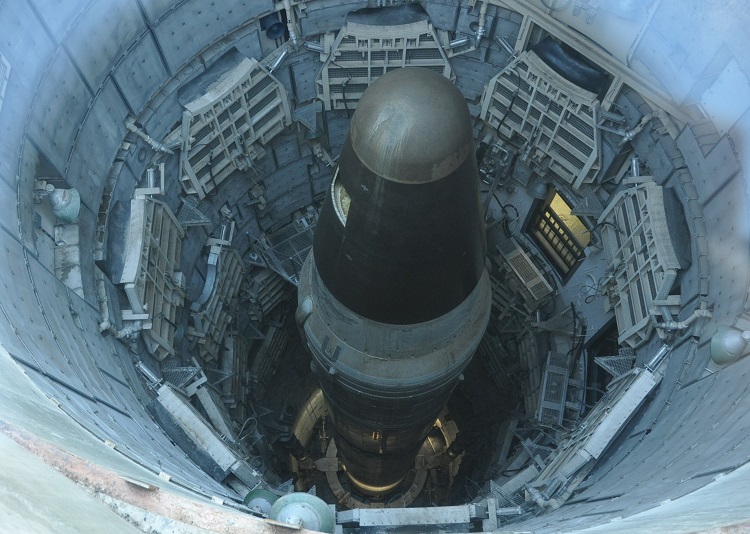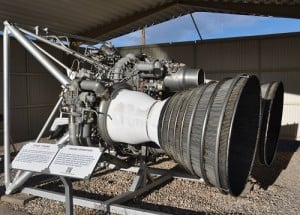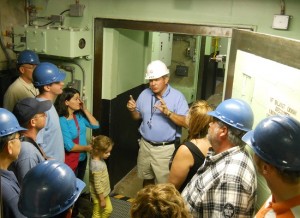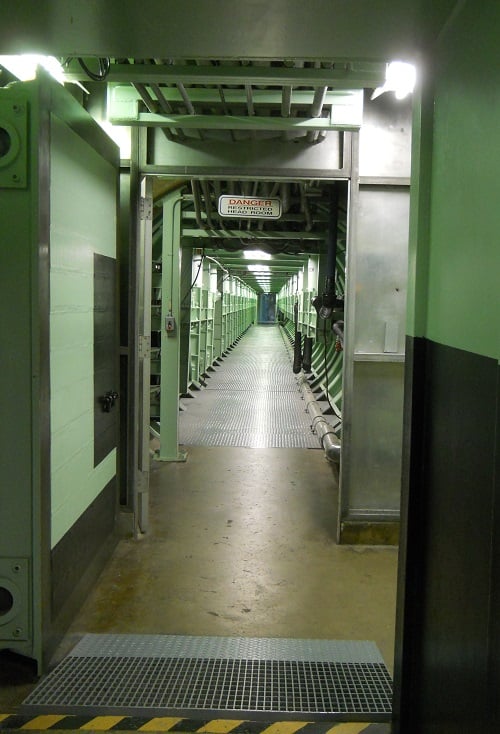What weighs 340,000 pounds, is over 100 feet tall, can fly 6,300 miles in 30 minutes, and is 410 times more powerful than the bomb dropped on Nagasaki? It is a loaded Titan II intercontinental ballistic missile, the largest operational land-based nuclear missile ever deployed by the United States.
Titan II missiles were decommissioned in the 1980s, but one inoperable missile and silo remain at the Titan Missile Museum near Tucson, Arizona, and you can tour the site to see one of the weapons that helped deter a nuclear attack during the Cold War.

Titan Missile, Photo Credit: Dave Helgeson
The Titan II missile program was part of a three-pronged Cold War nuclear weapon strategy that included manned bombers, land-based ballistic missiles and sea-launched ballistic missiles. The missiles required only 30 to 35 minutes to reach their intended targets, making them capable of first strikes on enemy territory. Their powerful nine-megaton warheads were designed to destroy enemy capabilities with one swift blow. Their long-range capability would allow Titan II missiles to hit targets in China and the Soviet Union.

Motors, Photo Credit: Dave Helgeson
Deployment of Titan II missiles was approved by the U.S. Air Force in 1959. Three Strategic Missile Wings (SMWs), each housing two Strategic Missile Squadrons (SMSs) of nine missiles each, were established at Little Rock Air Force Base Arkansas, Davis-Montham Air Force Base in Arizona and McConnell Air Force Base in Kansas. The first missile complex was placed on strategic alert on May 16, 1963, ready to launch its missile at any time.
While capable of a first strike, the Titan II was considered a retaliatory weapon. This means the missile was designed to withstand a nuclear near miss or a nuclear attack nearby.
“Peace through deterrence” was how the United States considered the weapon program. The Soviet Union knew that if it launched an attack against the United States, it would retaliate, resulting in mutual destruction of both countries.
For approximately two decades, 54 Titan II missile complexes across the United States stood on alert 24 hours a day, seven days a week. Some thought the program intensified the threat of nuclear war while others felt it prevented Armageddon.
The most heightened state of alert was on November 22, 1963, when President John F. Kennedy was assassinated. While news of this tragedy unfolded, officials ordered the launch keys be placed on the tables near the launch consoles while awaiting further instruction.
Since the Pentagon soon determined that the Soviet Union was not involved in the President’s death, the missiles were never launched. Had the missiles been launched, each would have been directed to one of three preprogrammed targets within Russia.

Museum Tour, Photo Credit: Dave Helgeson
During the 1980s, the weapons and silos were decommissioned and destroyed, with the exception of the installation near Tucson. The remaining silo and missile were rendered inoperable by arm reduction treaty mandates with Russia.
The site is still inspected regularly by Russian officials to verify that the silo and missile are non-functioning. In the 1990s, the silo became part of the Titan Missile Museum overseen by the Arizona Aerospace Foundation.
Nowhere else on earth can visitors get this close to an intercontinental Titan II ballistic missile in its original operational setting. This one-of-a kind museum provides visitors a rare glimpse into the technology employed when the threat of nuclear war between the U.S. and the former Soviet Union was a daily reality.
What was once one of America’s top secret places is now a National Historic Landmark, fulfilling its new assignment of preserving Cold War history for visitors from around the globe. The decommissioned Titan II missile at the museum, known as complex 571-7 when active as a military installation, is all that remains of the 54 Titan II missile sites that were on alert across the United States from 1963 to 1982.
The surface area of the Titan II launch facilities outside the museum building measures approximately 600 feet by 600 feet. All of the launch facilities were underground to protect them from attack.
The silo, built of heavily reinforced concrete, is 147 feet deep and 55 feet in diameter. To deflect and channel the exhaust gases from the missile, each silo was fitted with a flame deflector at the base and two exhaust ducts that ran up the length of the silo and vented to the surface. The interior of the silo features nine levels of equipment rooms and missile access space. The silo was covered with a steel and concrete lid that weighed 740 tons and could be slid open in 17 to 20 seconds.

Photo Credit: Dave Helgeson
Visiting the museum is free, but to really appreciate the size and scope of the missile and silo, taking the one-hour tour is money well spent.
The first stop on the tour is a video depicting the Titan’s history and its deadly nuclear delivery capability. Next you are taken outside to the open silo to look down upon the missile still in its launch position. On the surface are a decommissioned warhead, rocket motors and several antennas used to maintain communications in the event of a nuclear war.
From there you go underground deep into the heart of the site. Your guide explains how all essential equipment is mounted on springs to withstand anything but a direct nuclear strike. Then you pass through the 6,000-pound blast doors designed to protect the launch center from either a surface nuclear blast or the explosion of the missile within the silo.
The doors were designed to withstand an overpressure of 1000 psi. Once through the blast door, you walk along a Star-Trek like corridor to one of the upper levels of the silo. The 110-foot tall missile in the silo weighed 170 tons when it was fueled and ready to fly. Today it is empty and harmless, but it still looks lethal, ready to spring from its launch pad.
Next, you are off to the launch control center, which is contained in a dome-like reinforced concrete structure nearly 40 feet in diameter with three levels. The three floors within the launch center were suspended from the ceiling by springs to minimize shockwaves from a blast.
The control center provided space for all of the launch control and communications equipment, along with a kitchen, restroom and sleeping quarters for the four-person combat crew.
Once in the control room, your guide explains the functions of the equipment and walks you through a simulated launch. At the guide’s command, one guest flips the launch switch. Fortunately nothing happens and you are escorted back to the surface to visit the gift shop!
The Titan Missile Museum is an amazing, yet sobering place to relive history and learn how the United States assured peace during the Cold War.
When you go:
The Titan Missile Museum is at 1580 W. Duval Mine Rd. Sahuarita, Arizona, approximately 20 miles south of downtown Tucson just off of Interstate 19. The museum is open every day except Thanksgiving and Christmas. Hours are 8:45 a.m. to 5 p.m. One-hour guided tours are offered on the hour. There is plenty of parking for RVs.
Admission is $9.50 for adults, $8.50 for seniors and groups, $6 for children from 7 to 12 and free for children 6 and under.
Less than a mile from the museum is Green Valley RV Resort.

Will be coming out in Oct. Of 2018. Looking forward to visiting.
I did my graduate work at U of A in the early 70’s. A friend of mine was a Captain in the USAF and was one of those men who sat with his counterpart in the silo, waiting for orders to insert his launch key. And yes, they both carried 45’s on their hips in case the other one went nuts.
Next time we are in Tucson we’ll have to go to the museum. Thanks for this post!